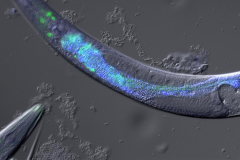The soil nematode Caenorhabditis elegans
offers several advantages to study the function of disease genes and their worm homologues. In 1998, it was the first multicellular organism of which the genome has been sequenced completely. One surprising result of this approach was that ~65% of the human disease genes have a counterpart in the worm. Screens to identify gene knockouts can be automated and large-scale setups have been devised with the recently developed RNA interference approaches that allow the temporal gene inactivation of hundreds, if not thousands, of genes in parallel experiments using microtiter-plate assays. Phenotyping the mutant morphology and behaviour is greatly facilitated by a complete cell lineage map and the existence of a wiring diagram of all 302 neurons. Despite its obvious simplicity, organogenesis and even complex neuronally controlled behaviours (e.g. associative learning and the response to noxious stimuli) can be studied and dysfunctions can be attributed to defects in individual cells. In addition, the animals are amenable to molecular, genetic and biochemical analyses allowing the identification of protein interactions and suppressor mutants and, thus, to the dissection of entire regulatory pathways.
A model for human disease-related genes and pathways
Several studies in recent years have established C. elegans as a superb model to evaluate the function of disease genes. They suggest that indeed the large degree of sequence similarity found in genes in C. elegans and human genomes results in a significant functional similarity of the encoded proteins. Most importantly, the major signalling pathways of C. elegans and vertebrates, including ras, Notch, TGFβ, wnt/wingless and insulin signalling are remarkably conserved.
Automation
In addition to the ease of genetic manipulations, this tiny nematode has one major advantage that might develop it into a superb tool for the biotech industry. C. elegans can easily be grown in microtiter plates in both 96- and 384-well formats. Because its receptor pharmacology is remarkably similar to that of humans, drugs and side effects can be tested in large scale using C. elegans and its mutants as an in vivo model (whole animal testing). Methods to automate the readout, for example to measure behavioural differences such as motility defects or the response to intoxication, are being developed at several places. Drug development using ‘humanized worms’ (e.g. C. elegans knockout strains expressing the homologous human disease mutant) in large scale is therefore feasible. And, perhaps the first effective medication against Alzheimer’s disease or Duchenne Muscular Dystrophy will, one day, be the result of a high-throughput pharmacological screening procedure using C. elegans as a whole-animal model.
C. elegans is currently the best studied animal model available.
Some facts about C. elegans
Since December 1998 the C. elegans genome (100 Megabases) is fully sequenced (The C. elegans Sequencing Consortium, 1998).
About 50-65 % of the currently known human (disease) genes have a homologue in C. elegans.
The positions, lineage, and ancestries of all 959 somatic cells, as well as the function of many of these cells, are known in detail.
The detailed anatomy and synaptic connectivity of each neuron in its nervous system has been analysed on the level of electron microscopy. Although the C. elegans nervous system is undoubtedly built extremely simple, it is highly specialised, because the 302 neurons represent 118 functional classes, which share many developmental and functional similarities with the human nervous system
C. elegans uses the same neurotransmitters as vertebrates and the pharmacology of their receptors is strikingly similar.
C. elegans has a short generation time (3 days), can easily be cultivated on agar plates and in microtiter wells. There are mutants for more than 3000 genes readily available; these can be stored in frozen stocks and recovered easily.
A large mutant library which allows the fast recovery of deletion alleles of any candidate gene is available to the lab. It is used to generate knock-out mutations of interesting genes.
C. elegans is ideally suited for large-scale functional analyses and drug discoveries

